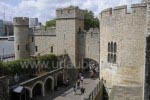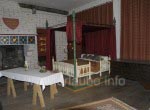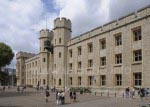|
|
Castles and Palaces of the Royals
No, we did not have a personal invitation and we did not see the Queen, as also we did not see Camilla and Charles. But viewing the royal castles, gardens, parks and museums is a great experience also without an audience with the Queen and a thing one should not miss in any case during the visit to London. Of course, sometimes the long queues in front of the royal rooms are daunting, but those who take their time will not be disappointed in any case. The history of the world power Great Britain is reflected here and shows the interested people an arquitecture, habits and art treasures that make understand that for many centuries, England played a very important role in the world and that for the Brits, the monarchy is still alive. Tradition is a typical english passion and where should it be more vivid than in the hideaway of the royals. Tower of LondonThe Tower of London is not a tower in a way one might imagine it as per its description, but a whole complex of buildings and fortifications. It is one of the most famous sightseeings of London, maybe even the most famous. The UNESCO has put the Tower of London on the World Heritage Site, a thing that emphasizes its significance. 
Already during the times of the Roman ocupation, a fortification was suposedly standing on this historical site. The remainings of this former city wall of the Roman Londinium are still visible today. William the Conqueror was the one who started building the White Tower around 1078 and therewith layed the foundation stone of the continuously growing complex of the Tower of London. William was motivated by concrete interests to built the White Tower outside the city walls of that time. The normans who occupied England for several centuries were not very popular and the building of the fortification was supposed to protect them against the Londoners. In the course of the time it was continuously expanded. Surrounded by a moat, a building ensemble is placed around the centre, the White Tower. 
By hearing the concept Tower of London, one first thinks of a jail. This is what the Tower was, but since the year 1303, also the crown jewels are kept in its interior, it served as an armoury, public record office, the coin was kept there and even an observatory. Temporarily, it also served as a royal palace, a thing that is noticeable by the dormitories of the royals during the round tour. 
Anyway, the Tower is primarily in memory as a jail and place of execution for personalities of the contemporary history. This consideration is not wrong, as the list of the prominent prisioners is long. In the Bell Tower, aaranged around 1190 by Richard I., Maria Tudor arrested her half sister, the later Queen Elisabeth I., for two months. Richard III. locked two of his nephews in the Tower and supposedely killed them; According to the order of the notorious Henry VIII, his second wife Anna Boleyn and his fifth wife, Catherine Howard, were decapitated. The list could be continued. As one can see, "blue blood" does not mean nobleness and strength of character. The last prisioner of the Tower was Rudolf Heß in the 20th century, the substitute of Hitler. Today, these dark times are fortunately over and the numerous visitors have nothing to worry about. The Tower of London has converted from a frightening place to a touristical highlight. And there is realy a lot to see. After the round tour through the building and the towers nobody will miss to visit the Waterloo Barracks at the north side of the inner courtyard. At the end, there is the famous exhibition of the crown jewels with the "Koh-i-Noor" and one of the "Stars of Africa" as also many other very valued pieces of jewellery. The material value is hard to estimate. This is why it is strictly forbidden to take pictures. During the visit of the treasury one has to get prepared for a massive crowd. 
Everywhere in the Tower of London, one comes across to the Yeoman Warders, better known as the "Beefeater", those ceremonial gate guards, who, according to their own statement, are the oldest bodyguards of the world. Since the year 1485, they are responsible for the guarding of the crown jewels and the prisioners of the tower. Today, their task mainly changed to greeting and guiding the tourists. 
The ravens also have a special significance for the tower. According to a legend, the British Empire should go down if the ravens abandoned the tower. Also if nobody really believes this proclamation, the eight "official" ravens of the tower enjoy a real protected life in which everything is done in order to protect them. Their only adversity are the trimmed wings, but this should not really disturb them . The best way to get to the Tower of London is by taking the tube up to Tower Hill or Tower Gateway. The opening times are from Tuesday to Saturday 09.00 a.m. to 06.00 p.m., Sunday and Monday from 10.00 a.m.to 06.00 a.m. from March to October. From November up to February, it is opened up to 05.00 p.m. Generally, there is a massive rush, so that one has to be prepared for some long waiting times at the cash. Those who own a London passport are in advantage, as with this, one can go straight to the entrance and it is free of charge. Otherwise, one pays 10.50 pounds. Buckingham PalaceWe first looked if the red-golden blue royal flag was flying on the roof of the Buckingham Palace, the sign that the Queen is present. But it was only the Union Jack. This was also not surprising, as traditionally, the royal suite spends the months of August and September in Schottland. During these months, one can view some of the more than 600 rooms of the palace, thereunder the throne room, the private painting galery and the State Dining Room. But the private rooms of the royal family are taboo as usual. A previous reservation is recommended, as the rush is huge. 
Since the coronation of Queen Victoria in the year 1837, the Buckingham Palace is the residence in London of the British Monarchs, thus place to live and place for official events as receptions of foreign state guests. The building was once built as a city house for the Duke of Buckingham, this is where its name comes from. In the year 1762, it was acquired by the King George III and reconstructed and expanded step by step until it got its definite function through Queen Victoria. One of the most famous and popular sightseeings of London are the daily changing of the guards with their characteristic bearskin hats that take place around 11.30 a.m. During the winter, this happens any second day, in case of very bad weather it is also possible that the changing of the guards is omitted. In order to have a good sight to this event, one should be there in time. 
In front of the palace, a well-kept complex with a statue attracts one's attention, the Victoria Monument. The height of 26 m is impressive and as worthwhile seeing as the more than 4 m heighted old-plated goddess of victory. The monument is surrounded by different allegories that should represent bravery, constancy, victory, truth, justice, art, agriculture and science. Thewith, Quenn Victoria, who was very popular, got a monument set, one of a total of ten in London. In the palace there is also the Queen's Gallery and the Royal Mews, two very interesting exhibitions. It is possible to view the palace in August and September daily from 09.30 a.m. to 04.30 p.m. The best way to get there is by tube up to the stations Queen Victoria, Green Park or St. James's Park. Hampton Court Palace and Windsor CastleProvided one has some more time available in London, one can afford an excursion to Hampton Court Palace. This royal palace is located at approximately 25 km southwest from London city and one can get there by train from the Waterloo Station or Paddington. A boat trip is also possible. Hampton Court Palace was originated on the complex of the manor of the Order of Saint John that was expanded in the 16th century to a palace in english baked-brick appearance, the tudor style. The west cladding remained in this style, the other buildings were renovated in the style of the rennaissance. Today, Hampton Court is considered as one of the most beautiful english royal palaces. What is also worth seeing are the statutorial rooms arranged by significant artists of the baroque era. It is also possible to view the wine cellar, the beer cellar and the kitchens that all provide an interesting impression of the provision of such a palace. Those who want to walk through the private gardens of a King will have the opportunity here. During the roundtour through the palace grounds one also gets to the private gardens of the royals. A special highlight for the children is the hedge labyrinth "The Maze". In the tennis court of Henry III one can see that tennis is not a kind of sports that was originated in these times. It is still played tennis on this court after the rules of that time. The opening times are from March to October on Mondays from 10.15 a.m. up to 06.00 p.m. and from Tuesdays to Sundays from 9.30 a.m. up to 06.00 p.m. During the six months of winter it is opened up to 04.30 p.m. Windsor Castle, since 900 years the summer residence of the royal family, is considered as the biggest castle of the world that is still habitated. If the banner of the Queen flyes from the Round Tower, then she is present. Anyway, the chance to see the Queen is very small. The Windsor Castle is located at approximately 35 km west from London and one gets there by train from the Waterloo Station or by bus from the Victoria Station. The castle that thrones on a chalk cliff over the Thames is, beside Westminster Abbey, an important burial place of English Kings. Beside others, here are the sepulchres of Henry III, Princess Magaret, her sister Elisabeth II. and Jane Seymour, the third wife of Henry VIII. What is also worthwhile seeing is the Winchester Tower, St. George's Chapel and the Albert Memorial Chapel. Queen Victoria made this chapel to be gloriously arranged for her deceased husband, Prinz Albert, with marble, mosaics, sculptures and glass paintings. During the absence of the corona, the state rooms can be viewed. Thus, one should hope the Queen is not at home. The entrance fee for adults is of 14,80 pounds, those who have London passport enter for free. Horse GuardsWhitehall, the road that begins at the Westminster Bridge and close to the Houses of Parliaments, is the synonym for the British government. The district with its Government Palaces and Ministries was named after the Whitehall Palace, a royal residence that burned down on the year 1698. If one walks alongside the street, the soldiers riding horses unvoluntarily stand out, that immobily hold a vigil in their glorious uniform right at the footpath. The building at which front the small shield houses stand, is Horse Guards, the casern of the "Household Cavalry". The distinctive building is of the 18th century. 
We were specially imoressed about the guard changing that takes place at the backside of the building every day at 11.00 a.m., Sundys at 10.00 a.m. The mounted guardsman hoist there and under some sharp commandos, the guard changing takes place. One department forms up in scarlet red coats with white plumes of feathers on the helmet and the other in blue coats with red plumes of feathers. The "red coats" are the Queen's life guards, the "blue ones" the blues and royals. In immediate vicinity of the Horse Guards there also is the Downing Street with the fampus house number 10, the domicile of the prime minister. But since Margaret Thatcher had the street blocked by iron gates, it is only possible to have a look to the house no. 10 from a distance. Kensington Palace and Kensington GardensKensington Palace became world wide famous through Princess Diana, the former wife of Prinz Charles. After her accidental death in Paris, tens of thousands pilgrimage to her last place of residence, the Kensington Palace. The palace itself is surely not an outstanding precious object, but the Kensington Park where it is located is surely worth to visit. 
Everything started with a country house that was built in the year 1605 that was restored to a residence by Christopher by order of Wilhelm III. The famous Queen Victoria was born in this palace and here she also learned about her succession to the throne. In front of the east side of the palace there is a monument that reminds on Victoria. At the north side, there is the orangerie, in which there is a coffee bar today. If the weather is fine, one can also make use of the outdoor sitting area and be served by the real english courtly personnel, but quality comes at a price; We payed more than 4 pounds for some cookies. 
Still today, the Dukes of Kent and Gloucester live in the palace. Anyhow, some parts of the castle can be visited, in the Royal Ceremonial Dress Collection there is a worthwhile seeing exhibition of uniforms and dresses of the English high aristocracy. In the state rooms of the 1st floor, one can view some rooms of the Queen Victoria and in the Queen's Gallery, (not to be confused with the Queen's Gallery of the Buckingham Palace) there are numerus portraits of English monarchs. 
By taking some time, the Kensington Gardens offer a welcomed relaxation in the big city in a complex similar to a park. Some promenades lead to a lake, passing some meadows and groves. In between, the are some statues and monuments, such as for example one of Peter Pan. Form March 1st to October 31st, it is opened from 10.00 a.m. to 06.00 p.m., otherwise up to 5.00 p.m. The entrance fee is of 12.30 pounds, 6.15 pounds for children. The entrance is free for the owners of a London passport. 
Author: Michael Nitzschke, Copyright: Patrick Wagner, www.tourist-guide.biz |
||